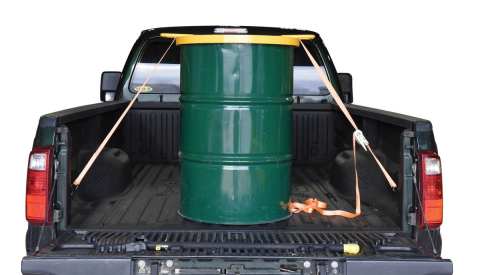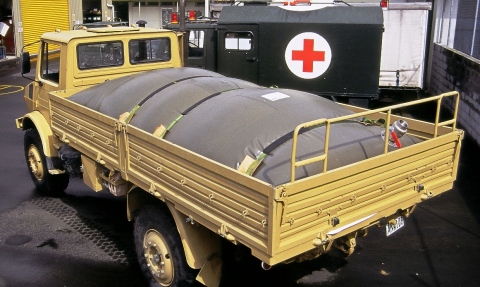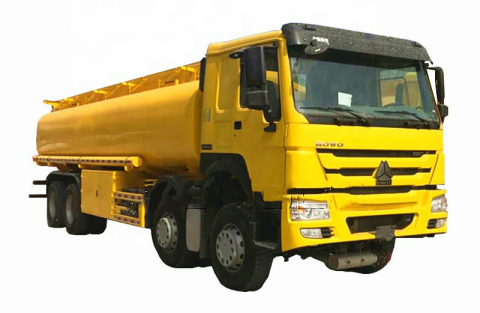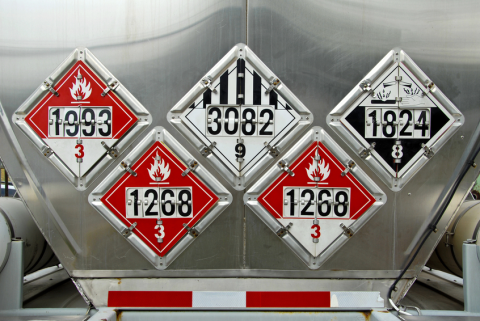Wherever fuel is transported even relatively short distances, humanitarian organizations should endeavor to transport fuel as safely as possible.
Road Transport of Fuel
Road transport is by far the most common method of fuel transport that humanitarian agencies will directly manage, and all precautions should be taken to ensure safe management. As a general rule, wherever possible transport and delivery of fuel should be outsourced to a qualified outside company. Self-managed transportation of fuel should ideally only be used when no other option is available, or when only limited quantities of fuel need to be transported.
Liquid fuels can easily move around inside their containers and dangerously shift weight while in transit. In all scenarios, fuel items transported by vehicle should be adequately braced and secured.
Drums
Transportation of fuel in drums is ideal for transporting relatively small quantities of fuel, or when specialized storage equipment isn’t available.
Drums containing fuel should always be properly braced and tied down. Review the road transportation section of this guide for more information on proper use of tie downs and working load limits.
Full drums should ideally be transported upright, along their flat edge to avoid rolling around while in transit. Avoid double stacking full drums unless there is specialized railing or securing mechanisms in place.
Both the loading and offloading points should be prepared to receive the drums. This includes handling equipment and ramps. If the delivery location does not have any capacity to offload, the vehicle may have to travel with portable materials suitable for making a ramp. Portable materials may include wooden planks, however whatever is used should be capable of supporting the weight of a full drum rolling on/off the bed of a vehicle.
Bladders
In some circumstances, fuel can be transported using full bladders. Bladders can come in many sizes, and can easily take up the entire bed of a truck.
Any vehicle transporting fuel using a bladder should be capable of carrying the full weight of the load. Large bladders can easily become very heavy, and transporters may not fully anticipate weight requirements.
Fuel bladders on a vehicle should be properly braced and secured, just like any other load. Tie downs need to accommodate the full weight of the fuel, and the bladder itself should be properly rated for use as mobile transport. Consult with the manufacturer before using a bladder for transport purposes.
Tanker Trucks
Tanker trucks are purpose-built vehicles designed to transport liquids, including fuel. Tanker trucks for fuel are usually only owned and operated by private companies. If a humanitarian agency plans on owning and operating its own fuel tanker vehicle, it will need to ensure that the vehicle meets standards for containing/transporting fuel, is registered and legally able to operate in the local context, and that the drivers are fully certified and trained to operate a specialized vehicle. Prior to buying a fuel tanker truck, agencies should consult with a professional vendor, and with local authorities that manage road safety.
Road Transport Safety
Humanitarian agencies may own or operate their own vehicles, or may take a full responsibility in loading, securing and even driving vehicles transporting fuel. Even if regulations don’t specifically stipulate them, there are several steps agencies should follow:
- Never ship fuel with any chemicals, combustible items, or other dangerous or reactive substances. If possible, avoid intermixing fuel with anything else in transport.
- Understand the local context – move the vehicle when is safest time of day and along the safest route.
- Avoid moving vehicles containing fuel through cities and inhabited settlements wherever possible.
- Instruct staff and drivers on proper transport and handling methods.
- Place signs in local languages indicating:
- Warnings that the vehicle has combustible fuel.
- Signs should prohibit smoking around the vehicle.
Please consult the dangerous goods section of this guide for more information transportation of hazardous materials.
Regulations
National and local regulations regarding the transport of fuel vary from context to context. These regulations might include:
- Specialized licenses or certifications for drivers.
- Limits on the overall volume of fuel that can be transported in different types of vehicles.
- Limitations on roads, routes, and hours of operation.
- The requirement to notify authorities in advance of vehicle movement.
- The need for specialized signage and placarding to mark vehicles.
Humanitarian agencies will need to speak with local police and local authorities to fully understand requirements.
Example markings on the back for a tanker truck:
Air Transport of Fuel
The transport of fuel using aircraft is highly regulated. International aviation safety standards strictly limit types, quantities, packaging and marking of fuel for different types of aircraft. Some aircraft – such as passenger aircraft – may specifically completely prohibit the transport of fuel as cargo.
Prior to sending any fuel – liquid or compressed gas – by air cargo, humanitarian agencies should consult with the airline and/or the forwarder organizing the shipment.
- All fuel items should be clearly marked, indicating the UN ID number and having the appropriate label marking.
- Packages containing fuel should have the appropriate package size/overpacking requirements.
- Fuel items for shipment should be segregated from the rest of the cargo, or on the outside/top of a pallet for easy identification by loaders.
- Proper shippers’ declaration of dangerous goods and material safety data sheets should be supplied.
Under no circumstances should humanitarian agencies attempt to ship fuel without notifying the airline/forwarder in advance. Serious injury or death may occur from unmarked or unidentified fuels in air cargo, and individuals and agencies can be subject to fines or jail time for failing to disclose fuel.
Other Modes of Transport
The requirements around transporting fuel through other means varies from context to context.
- Sea transport of fuel is feasible, however unlikely that fuel would be transported in small quantities. For organizing fuel using commercial transport, agencies should consult forwarders and follow all documentation guidelines.
- Transporting fuel using river barge is common and largely considered safe. Agencies should consult with the transport provider for proper procedures for packaging and loading.
- Use of smaller boats or pack animals to transport fuel is also acceptable, however all precautions for securing, weight and overall handling should be followed at all times.





